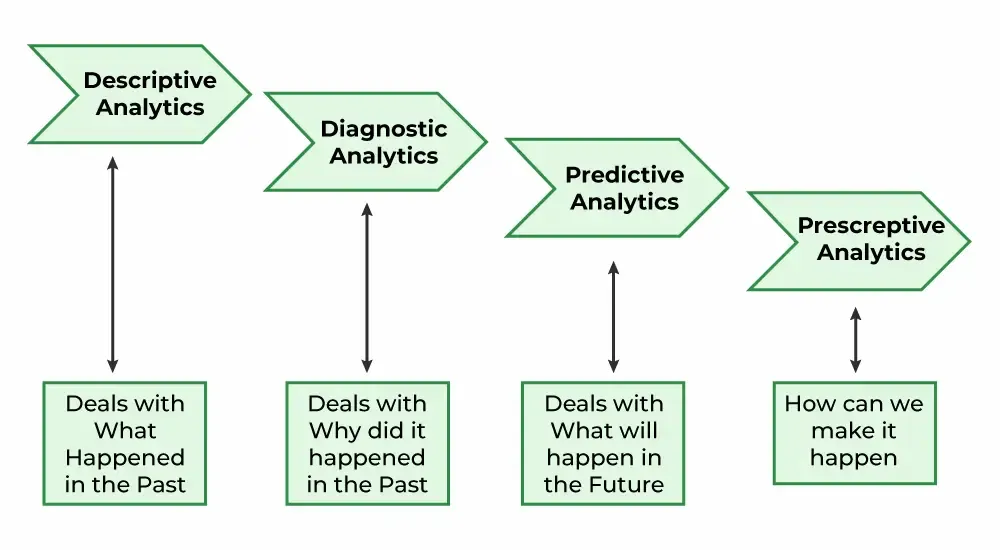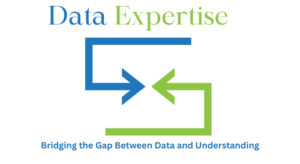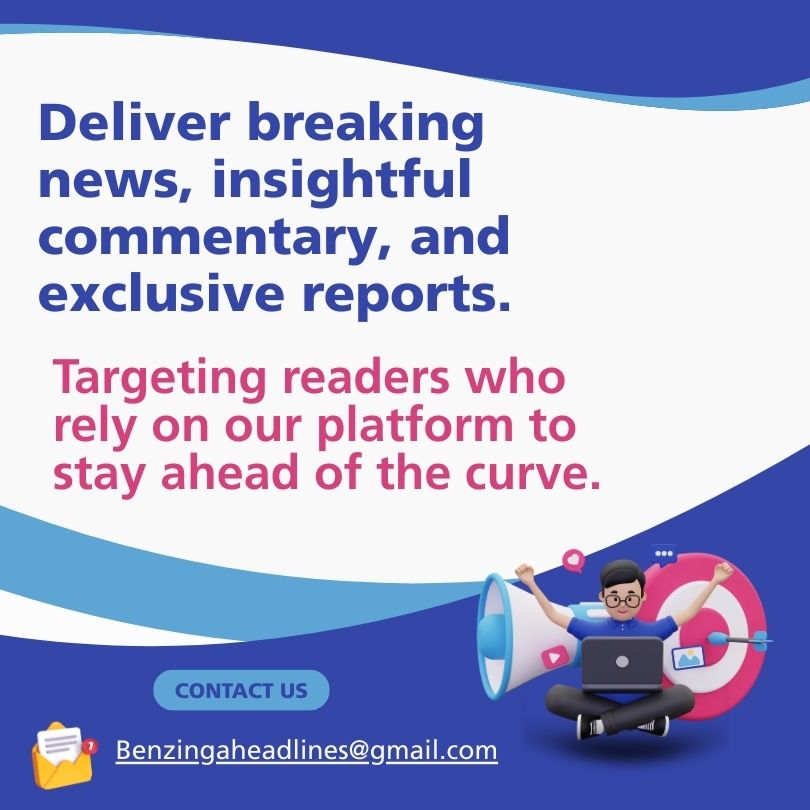In the last decade, data analytics has shifted from being a support function to becoming the strategic core of decision-making. Organizations that once made decisions based on intuition now rely on advanced analytics to predict, optimize, and personalize their operations.
The future of data analytics is not just about faster processing or larger datasets—it’s about transforming industries, reshaping customer experiences, and even redefining how governments function. With businesses generating over 328 million terabytes of data per day (Statista, 2024), the challenge lies in not just storing but extracting meaningful insights at scale.
The Evolution of Data Analytics: From Descriptive to Predictive and Beyond
Data analytics has evolved across four generations of maturity:

- Descriptive Analytics: Focuses on historical data and reporting.
- Diagnostic Analytics: Explains why something happened using root-cause analysis.
- Predictive Analytics: Leverages statistical models and machine learning to forecast future trends.
- Prescriptive Analytics: Provides recommendations for optimal decision-making.
The future of data analytics is steering toward autonomous analytics, where AI-driven systems automatically detect anomalies, generate insights, and recommend decisions in real time.
Current Landscape of Data Analytics
Today, companies use tools like Power BI, Tableau, Google BigQuery, and Apache Spark to extract insights from structured and unstructured datasets. Machine learning libraries in Python and R empower data scientists to deploy predictive models.
But despite this progress, 80% of corporate data is still underutilized (IDC, 2023). The future lies in breaking these silos, enabling seamless collaboration across functions, and scaling analytics from the data science team to the entire organization.
Key Trends Driving the Future of Data Analytics
Artificial Intelligence and Machine Learning Integration
AI-driven analytics is pushing boundaries, allowing businesses to automate anomaly detection, forecast demand, and personalize marketing campaigns. Netflix’s recommendation engine and Amazon’s pricing optimization are prime real-time examples.
Cloud-Based Data Analytics
The rise of Snowflake, AWS, and Azure Synapse is making analytics scalable and cost-efficient. Cloud platforms allow enterprises to ingest, store, and analyze petabytes of data in real-time.
Edge Analytics for Real-Time Decision Making
With IoT and connected devices, edge analytics enables data processing at the source. For instance, in autonomous vehicles, edge analytics decides braking and navigation without relying on cloud latency.
Augmented Analytics for Business Users
Augmented analytics leverages AI-powered insights to empower non-technical business users. Tools like Qlik Sense and Tableau’s Explain Data are pioneering this shift.
Data Democratization and Self-Service Platforms
Self-service analytics platforms empower employees at all levels to generate insights. The future of data analytics will depend heavily on this democratization to unlock untapped business value.
Emerging Technologies in the Future of Data Analytics
Generative AI in Analytics
Generative AI models like ChatGPT and Gemini are reshaping analytics by enabling natural-language queries and even auto-generating predictive models.
Natural Language Processing in BI Tools
BI platforms are integrating NLP to allow conversational interactions. Example: “What were Q1 sales in Europe?” can be asked directly to a BI dashboard.
Automation and No-Code Data Pipelines
Tools like Alteryx, Zapier, and Apache NiFi simplify ETL pipelines. This democratization helps non-programmers leverage analytics without writing complex code.
Quantum Computing and Its Role in Data Analysis
While still in its infancy, quantum computing promises to revolutionize big data analytics by solving optimization problems at speeds unattainable by classical systems.
Industry-Wise Impact of Data Analytics in the Future
- Healthcare: Predictive analytics will advance precision medicine by tailoring treatments to genetic profiles.
- Finance: Fraud detection using machine learning will prevent billions in cybercrime losses.
- Retail: Customer sentiment analysis will drive hyper-personalized shopping experiences.
- Manufacturing: Predictive maintenance will save industries billions by reducing downtime.
- Government: Smart cities powered by IoT and analytics will optimize traffic, utilities, and security.
Challenges and Ethical Considerations in the Future of Data Analytics
While opportunities are immense, challenges remain:
- Data Privacy Regulations (GDPR, CCPA)
- Algorithmic Bias in AI Models
- Talent Gap in Data Science and AI
- Integration of Legacy Systems with New Platforms
Ethical frameworks and responsible AI practices will be central to sustaining trust in analytics systems.
Real-Time Case Studies and Practical Examples
- Spotify: Uses analytics for playlist personalization, predicting listening patterns.
- Tesla: Edge analytics in autonomous vehicles.
- Walmart: Real-time supply chain analytics to optimize inventory.
- Pfizer: Predictive analytics in vaccine development during COVID-19.
Preparing for the Future: Skills and Strategies for Organizations
Organizations must focus on:
- Upskilling workforce in AI, ML, and cloud analytics.
- Investing in data governance frameworks.
- Building hybrid cloud and edge infrastructures.
- Adopting explainable AI (XAI) for transparency.
Hyperautomation in Data Analytics
One of the most transformative directions in the future of data analytics is hyperautomation, where every stage of data analytics—collection, cleaning, integration, analysis, and visualization—is increasingly automated. Unlike traditional automation that focuses only on repetitive tasks, hyperautomation leverages AI, RPA (Robotic Process Automation), and advanced ML models to create end-to-end autonomous data pipelines.
For example:
- A retail chain can automatically pull data from its POS systems, clean it, merge it with customer loyalty data, and run real-time demand forecasts without human intervention.
- Tools like UiPath, Automation Anywhere, and Alteryx are emerging leaders in enabling such fully automated pipelines.
This approach is crucial for businesses that need real-time responsiveness, especially in finance and logistics.
The Convergence of Analytics with Digital Twins
A digital twin is a virtual replica of a physical entity (like a factory, airplane, or even a city). When combined with advanced analytics, digital twins can simulate various “what-if” scenarios before real-world implementation.
- In manufacturing, companies can predict machine failures before they occur.
- In healthcare, digital twins of human organs can simulate drug responses.
- In smart cities, traffic flow optimization can be modeled virtually before deploying solutions.
The future of data analytics will heavily depend on such simulation-based decision-making, ensuring safer, faster, and cost-efficient innovations.
Responsible and Explainable AI in Analytics
As AI models become more embedded in decision-making, explainability is becoming critical. The challenge with advanced ML and deep learning models is their “black box” nature.
To build trust, Explainable AI (XAI) is emerging, enabling stakeholders to understand why a model gave a certain prediction. For example:
- A bank’s credit scoring model not only denies a loan but also explains which risk factors influenced the decision.
- Healthcare AI provides rationale for treatment recommendations, making doctors more confident in AI-driven insights.
Regulators like the European Union’s AI Act are pushing for such transparency, making explainable analytics a non-negotiable factor in the future of data analytics.
The Shift Toward Data Fabric and Data Mesh Architectures
The traditional centralized data warehouse model is being challenged by data fabric and data mesh approaches.
- Data Fabric: Provides an integrated layer of data and connecting processes, enabling a unified analytics ecosystem across hybrid cloud environments.
- Data Mesh: Shifts ownership of data to domain-specific teams, treating data as a product instead of a centralized IT-managed asset.
Both these approaches empower scalability and agility, which are crucial for enterprises that want to future-proof their analytics infrastructure.
Multimodal Analytics: Beyond Numbers and Text
The future is not just about analyzing structured datasets. Multimodal analytics involves integrating multiple data forms—text, images, audio, video, and IoT sensor data—into unified insights.
For example:
- In healthcare, combining patient records (text), MRI scans (image), and wearable device data (IoT) can produce more accurate diagnostics.
- In marketing, analyzing social media images (visual), tweets (text), and sentiment (voice analysis) gives a 360-degree view of customer behavior.
Companies that embrace multimodal analytics will have a competitive edge, as they won’t just rely on spreadsheets but on holistic, contextual insights.
The Role of 5G and Real-Time Analytics
With 5G networks, data transmission will reach speeds up to 100x faster than 4G, revolutionizing how real-time analytics works.

- Autonomous vehicles will rely on 5G-powered analytics for instant road safety decisions.
- Retailers will deliver real-time personalized ads to shoppers in stores.
- Smart factories will use predictive maintenance analytics in real time to prevent downtime.
The future of data analytics will be defined by how organizations harness ultra-low latency data transmission to enable instant decision-making.
Data Marketplaces and Monetization
Traditionally, companies analyzed only their internal datasets. The next wave is data monetization, where businesses buy, sell, and exchange data in secure data marketplaces.
For instance:
- A logistics company may purchase weather and traffic datasets to enhance delivery predictions.
- Healthcare providers may use anonymized patient data shared through secure blockchain-based data exchanges to improve research.
Platforms like AWS Data Exchange are pioneering this movement. By 2030, data itself will become a primary business product, not just a by-product.
Federated Learning for Privacy-Preserving Analytics
One of the biggest challenges is ensuring privacy while leveraging data. Federated learning allows companies to train ML models across multiple decentralized datasets without actually sharing the raw data.
- Google uses federated learning in Android devices to improve predictive text without accessing users’ personal conversations.
- Healthcare systems can collaborate on disease detection models without compromising patient privacy.
This ensures that the future of data analytics will be collaborative yet privacy-conscious.
Human-Centered Analytics and Data Storytelling
Even the most advanced analytics is useless if decision-makers cannot interpret it. That’s why the future lies in data storytelling, where complex analytics outputs are transformed into narratives, visuals, and contextual insights.
- Tools like Tableau Story Points, Power BI storytelling, and Flourish allow organizations to turn dashboards into compelling narratives.
- Instead of showing raw graphs, analytics platforms will explain insights in plain English, aligned with business objectives.
This approach ensures that analytics insights don’t just remain in data teams but are actionable across the organization.
The Ethical Future of Data Analytics
Beyond technology, the ethics of analytics will shape the future. Concerns like:
- Bias in algorithms (AI discriminating in hiring or lending)
- Data privacy and consent (ensuring GDPR/CCPA compliance)
- Environmental impact of analytics infrastructure (large data centers consume massive energy)
Future frameworks will emphasize fair, ethical, and sustainable analytics practices.
Conclusion: Shaping a Smarter Tomorrow with Data Analytics
The future of data analytics promises a world where decisions are faster, smarter, and more ethical. Companies that embrace AI-driven, democratized analytics will not only gain a competitive edge but also reshape industries in ways that were once unimaginable.
Data will no longer just support decisions—it will make decisions.
FAQ’s
How can data analytics transform your business?
Data analytics can transform your business by turning raw data into actionable insights, helping improve decision-making, optimize operations, enhance customer experiences, and drive growth.
What will be the future of data analytics?
The future of data analytics lies in AI-driven automation, real-time insights, predictive and prescriptive analytics, enabling businesses to make smarter, faster, and more personalized decisions.
What is the future of business analytics?
The future of business analytics will be shaped by advanced AI, cloud-based platforms, real-time data processing, and predictive modeling, empowering organizations to stay competitive with data-driven strategies.
Does a Data Analyst have a good future?
Yes, data analysts have a strong future as businesses increasingly rely on data-driven decision-making, with high demand across industries for skills in analytics, visualization, and business intelligence.
What is the trend in data analytics in 2030?
By 2030, data analytics will be AI-driven, real-time, and widely accessible, with a focus on predictive and prescriptive insights, automation, and strong data privacy, transforming how businesses make decisions.




